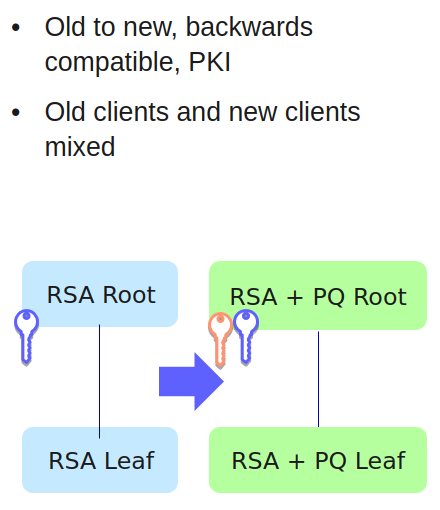Hybrid CA
The following provides information on Hybrid Certificate Authorities (CAs) and hybrid certificates.
For information on how to create a Hybrid CA, see Creating a Hybrid CA.
To address the possible threat to classical algorithms posed by future quantum computers, Post-Quantum Cryptography (PQC) algorithms are being standardized. The National Institute of Standards and Technology (NIST) defines that the goal of post-quantum cryptography (also called quantum-safe cryptography, and quantum-resistant cryptography) is to develop cryptographic systems that are secure against both quantum and classical computers and can interoperate with existing communications protocols and networks.
Hybrid cryptography combines classic asymmetric cryptography with post-quantum asymmetric cryptography to enable a migration path for systems with multiple components that cannot all be upgraded or replaced at the same time.
Hybrid PKI Migration
One migration path to implement PQC algorithms and upgrade existing Public Key Infrastructures (PKIs) is using hybrid certificates that have both classic and post-quantum keys and signatures.
A new, backward-compatible PKI set up with hybrid certificates, can issue certificates to PQC-capable devices, and non-PQC-capable devices will simply ignore the PQC algorithms and negotiate classic cryptography.
Hybrid CA Migration Example

Hybrid Certificates
Hybrid X509 certificates are created as multiple public key algorithm certificates and allow the use of alternative keys and signing algorithms, as specified in ITU-T X509 (10/2019) clause 9.8.
The following is placed into certificate extensions:
Alternative public key
Alternative signature algorithm
Alternative signature value
Hence, the implementation does not need to affect current behavior and any new extension marked as non-critical can be processed by existing systems. Thus, classic algorithms and PQC algorithms can live side-by-side until migration to quantum-safe PKIs is complete.
A Hybrid Certificate Authority (CA) is an X509 CA with two key pairs and two signing algorithms, where a combination of classic algorithms and PQC algorithms is used. The Alternative Signing Algorithm and the Alternative Certificate Signing Key in EJBCA are one of the PQC algorithms ML-DSA or FALCON.
Note that until NIST publishes the final standards for the FALCON PQC algorithm (to be standardized with the name FN-DSA), the parameters, configurations, and other details are to be considered changeable. Using the algorithms should until then be for testing purposes only.
The self-signed certificate of a hybrid CA will have two signatures, as will any certificate issued by that CA. A hybrid CA is a regular X509 CA, with the following exceptions:
It is not possible to create a non-hybrid Sub CA (that is, a Sub CA with only one classic public key and one classic signing algorithm) under a hybrid Root CA.
It is not possible to create a hybrid Sub CA under a non-hybrid Root CA.
The following certificate extensions and OIDs are used for hybrid certificates:
Extension | OID |
|---|---|
id-ce-subjectAltPublicKeyInfo | 2.5.29.72 |
id-ce-altSignatureAlgorithm | 2.5.29.73 |
id-ce-altSignatureValue | 2.5.29.74 |
As specified in ITU-T X509 (10/2019) clause 7.2.2, when a hybrid certificate is created, the altSignatureValue value will be the result of excluding the signature component and the altSignatureValue extension, while including all other DER-encoded parts in the alternative signature. The native signature value will then be the result of all DER-encoded parts, including the subjectAltPublicKeyInfo, the altSignatureAlgorithm, and the altSignatureValue extensions. This also means that a relying party will have to re-DER-encode the certificate, depending on whether they have migrated to PQC systems or not, in order for a validation to succeed.
Related Content
For information on how to create a Hybrid CA, see Creating a Hybrid CA.
.png)